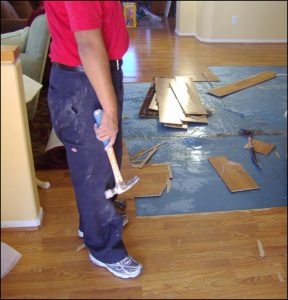Water damage you know about in your home isn’t nearly as bad as water damage you don’t know about. You can remove the obvious when you see it, then take preventative action against long-term damage. When you can’t see it and it has gone undetected for weeks, and sometimes months, the permanent damage may already be done making repair costs, cleaning and restoration dramatically more expensive.
Prevention is the best approach. Water disasters can occur for a number of reasons such as flooding, overflowing of sinks or tubs, pipe leaks, water back-up, toilets and sewer systems malfunctioning. Most of these problems are visible, and they are the greatest culprits for hidden water damage. This is where prevention comes into play. Being proactive with inspecting areas of your home on a regular basis can detect the signs of unwanted water, locate the problem’s source and allow quick shut-off and repairs of the issue before it becomes a disaster.
But, what should you be looking for when it comes to suspected or unsuspected water damage? A good beginning is to access your home’s exterior, specifically the gutters. They are designed to move water away from your home during rain storms and other damp weather. If there is dripping from the gutters or even overflow, there’s probably a back-up or clogging of the channel. It is imperative that the water run freely away from your structure.
Downspouts should always extend a few feet out from your home so they deter water from moving under the foundation. A certain sign of a water problem is stationary water or accumulation around the perimeter of your property. If water is damming against the outside walls then re-grading may be required to change the slope and fix the problem.
Reading your water meter is a good way to detect a water issue. If you have a base reading you will notice when any changes or increases occur that can not be explained and might be due to leaks. This procedure could save you a high water bill. If a leak is suspected it is best to bring in a water leak detection specialist. Finding the leak before you find the symptoms will avoid disasters and save money.
Laminate and wood floors will always give you an indication if there is water damage, as there will be staining, warping or softening of the surface. In addition, kitchen appliances can also leak affecting flooring, even drywall around the area. Upstairs leaks can be damaging to the first floor ceiling so any stains on the ceiling can alert you to second story unwanted water.
Every window frame or door should also be checked for softening and stains. Broken seals can allow condensation and water to seep in, which can create a slowly developing problem. Repairing these broken seals with silicone now, can deter mold removal later.
These are just a few ways to stay ahead of a homeowner’s potential water problems. By inspecting your home continuously, especially water areas, and detecting any problems early-on, you can avoid potential damage and costly clean-up and repairs.
